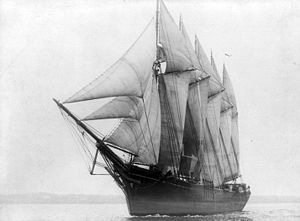

The Governor Ames was a five-masted schooner launched on December 1, 1888 by the Leavitt Storer shipyard of Waldoboro, Maine, United States; named after Adelbert Ames (former Governor of Mississippi), the vessel was the first five-masted schooner and was the world's largest cargo vessel in the late 19th century.
I've been improving its Wikipedia article. There are two nice pictures of the vessel available from the Library of Congress archives, which I've added to the article; I'm also grateful for the New York Times' opening of its archives, which has provided quite a few fine sources.
It's rather disturbing to the modern mind to realize just how much loss of life was involved in the coastal shipping trade back then. For example, all eleven six-masted schooners that were built were lost at sea, and so was the Governor Ames, off Cape Hatteras on the North Carolina coast in 1909, with the loss of fourteen lives and only one survivor.
It's also made me a lot more aware of the economics of shipping and what truly killed off the sailing ship. It wasn't speed; sailing ships were generally faster. The increasing cost of skilled labor was a big part of it. The schooner lasted much longer than other types of sailing vessel because it required only a small crew. Interestingly, such large and economical sailing vessels could only be built because of the steam engine; steam-powered winches were used to hoist the sails, haul the anchor chains, and operate pumps to keep their leaky hulls afloat. With steam winches, a small crew could handle a huge sailing vessel.
These huge sailing vessels were bulk carriers; most were built for the coal trade, taking huge cargoes of coal from the Southern ports to the industrial North-Eastern United States. The Governor Ames could carry 3,000 tons of coal in its giant holds. Similar vessels were built for the timber trade, and in fact the Governor Ames spent about five years hauling timber, including passing Cape Horn twice and visiting Australia and Argentina before returning to the coal trade for which it was built.
What finally killed these ships off was their greater risk of sinking compared to a steamer, their unpredictability since they were dependent on the winds, and the difficulty of building a sailing ship as large as the bigger steamers. Furthermore, good crewmembers saw the future coming and wanted steamer experience, not sail.

No comments:
Post a Comment